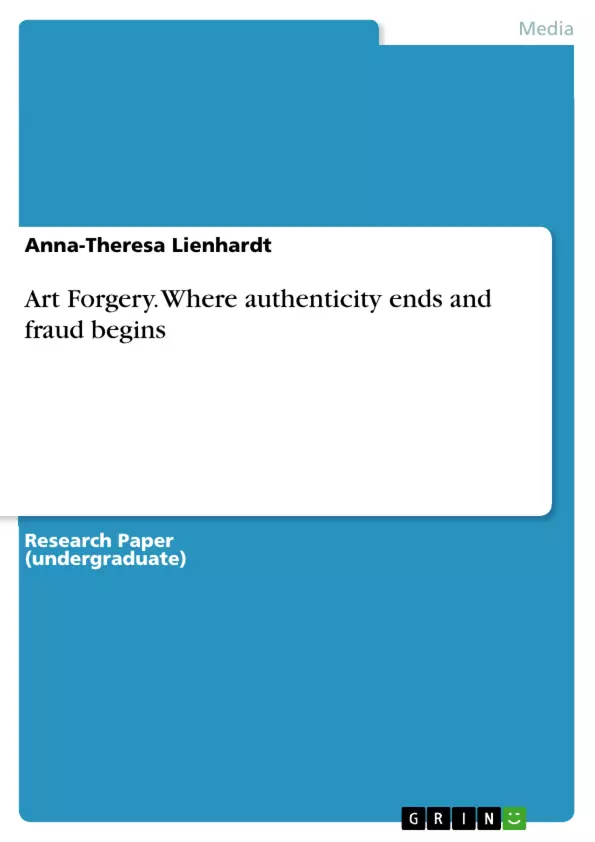The research paper presents the different points of view which exist concerning art forgery and explains the reasons why these are diverging in such a way. At first, the paper asserts that art forgery has to be defined with the help of its contrary, which is the original and the term of ‘authenticity’. However, the definition of an authentic or an original artwork yielded no useful results. Every generation, every society has an own notion of authenticity and the term ended as a contestable one. Nevertheless, the paper defines art forgery as an illegal imitation of another artist's artwork and its selling with the name of the original artist. In the following, the legal, the art world's and the economic perspective reveal that art forgery causes many differing notions about it. Legally, copyright laws exist to grant authors exclusive reproduction rights and the only right on their property. Thus, art counterfeits are frauds whose originators have to be sentenced. The art world, however, is completely divided when it is about assessing an art forgery. A lot of people see it as mere pastiche and deny its aesthetic value, while others know to esteem the art forger's achievements and proficiencies. The economy, on the hand, sees art forgery as the creator of financial expenses and trouble within the market, but, on the other hand, it also accepts that art copying causes benefits and positive effects, too. Therefore, the economy's statement was to lower the restrictions of art forgery as this only leads to the loss of creative energy and art copying going underground.
Finally, the case studies of Han van Meegeren, Andy Warhol and Susie Ray reveal the reasons for the controversies on art forgery: Some art counterfeits are legally clear cases, while others are highly contestable. There may be a legal way to forge works of art but do these copies have an authenticity or an ‘aura’? And all the time, the art world is embarrassed, annoyed and furious as the forgery had made a fool of it. In the end, art forgery is a question of interpretation; there is no clear answer how to assess it in its whole. It always depends on the sight of view one takes.
Table of Contents
- Art forgery: a controversial issue…
- Definition of 'art forgery' and its relation to the term 'authenticity'.
- Original or fake? Art or fraud? An attempt to understand the phenomenon of art forgery…
- Three perspectives…
- The legal perspective…
- The art world's perspective
- The economic perspective…
- Case studies…
- The art forger Han van Meegeren
- The controversial working practices of Andy Warhol…
- The original copies of Susie Ray…
- Three perspectives…
Objectives and Key Themes
This research paper aims to explore the various perspectives surrounding art forgery, examining why opinions on this issue differ so greatly. The paper seeks to understand the complexities of art forgery by considering legal, art world, and economic viewpoints.
- The definition of art forgery and its relationship to the concept of authenticity.
- The legal perspective on art forgery, including copyright laws and the penalties for counterfeiting.
- The diverse opinions within the art world regarding the value and legitimacy of art forgeries.
- The economic implications of art forgery, including the impact on the art market and the potential benefits of art copying.
- The reasons behind the controversies surrounding art forgery, illustrated through case studies.
Chapter Summaries
The paper begins by defining art forgery and exploring its connection to the concept of authenticity. It highlights how the perception of forgery has changed over time, shifting from a form of practice and learning to a controversial issue. The paper delves into the legal, art world, and economic perspectives on art forgery, revealing divergent views on its legal status, artistic merit, and economic consequences. The analysis includes case studies on Han van Meegeren, Andy Warhol, and Susie Ray, showcasing the complexities and controversies surrounding art forgery and its implications for artists and art markets.
Keywords
The paper focuses on the multifaceted nature of art forgery, exploring its legal, artistic, and economic implications. It delves into key concepts such as authenticity, originality, copyright, art market, and the aesthetic value of art copies. The paper also examines the motivations and techniques of art forgers, as well as the controversies surrounding their works. Key terms include art forgery, authenticity, originality, copyright, art market, art forger, and case studies.
- Citar trabajo
- Anna-Theresa Lienhardt (Autor), 2013, Art Forgery. Where authenticity ends and fraud begins, Múnich, GRIN Verlag, https://www.grin.com/document/273719



